|
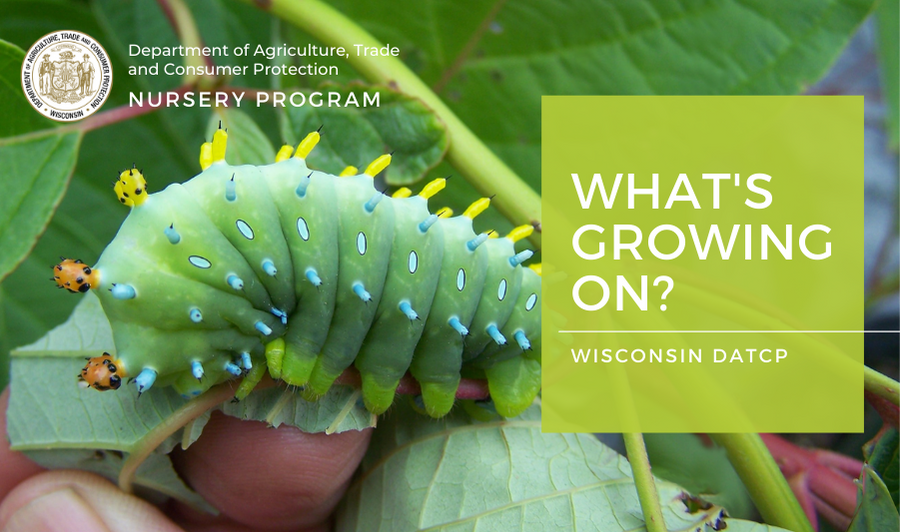 _____________________________________
Dear Wisconsin nurseries, Christmas tree growers, and gardeners:
Growing degree days (GDD)(simple B50) as of September 14 were 1676 in Bayfield, 1918 in Medford, 2012 in Wausau, 2318 in Hancock, 2404 in Green Bay, 2458 in Racine, 2644 in Madison, and 2739 in La Crosse. A few pests in a vulnerable-to-treatment stage include final applications for flat-headed and round-headed apple tree borers and pine needle scale (1600-1700); first applications for locust borer (1800-2100); final applications for two spotted spider mites (2100-2200); and fall applications for zimmerman pine moth (2700-2900), cooley and eastern spruce gall adelgids (2800-3000) and spruce spider mites (2900-3100).
Take a moment to read through a few updates from the DATCP nursery and other Plant Protection programs. Please send any feedback, questions, or ideas for future e-news updates to datcpnursery@wisconsin.gov.
Having trouble viewing this email? View it as a Web page.
_____________________________________
|
|
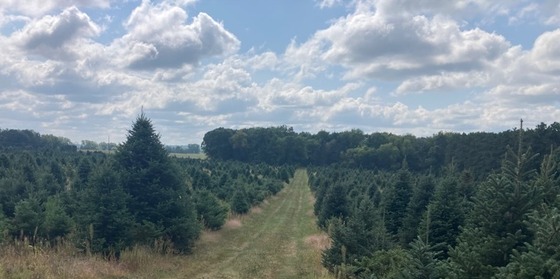 Christmas tree field ready for harvest in western Wisconsin | DATCP T. Boyle
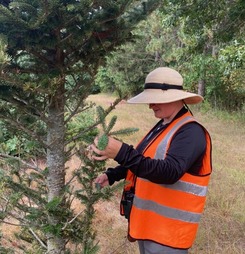
Christmas tree inspection season has begun! From September through November, DATCP staff will be inspecting Christmas tree growing fields before transitioning to conducting Christmas tree lot inspections. During field inspections, staff will be prioritizing Christmas tree growers that ship out of state and/or request a Plant Health Certificate (PHC), with the goal of completing these inspections by mid-October. Inspections are required for any grower shipping Christmas trees out of the spongy moth quarantine, as a part of the compliance agreement signed annually with USDA.
Starting mid-November, staff will begin inspecting Christmas tree lots. During lot inspections, inspectors verify cut Christmas trees are obtained from a licensed Christmas tree grower (if Wisconsin-grown stock is being sold) and inspect Christmas trees, wreaths, roping, and other décor containing cut evergreen material for pests or diseases.
Inspectors will also be checking with vendors that import cut Christmas trees, boughs, and other decorative material from any elongate hemlock scale (EHS) infested area – Connecticut, Delaware, Georgia, Kentucky, Maine, Maryland, Massachusetts, Michigan, New Hampshire, New Jersey, New York, North Carolina, Ohio, Pennsylvania, Rhode Island, South Carolina, Tennesee, Vermont, Virginia, and West Virginia. In July, Wisconsin instituted an exterior quarantine for EHS, which requires growers or vendors importing stock from an infested area to sign an annual compliance agreement with DATCP. Documentation verifying the imported plant material is free of EHS, and pre-notification of incoming shipments of cut trees or material, are requirements of the compliance agreement. If no compliance agreement has been issued, each shipment of regulated material from an infested area must be accompanied by a state phytosanitary certificate verifying the materials were inspected by a pest control official from the state of origin.
If you have questions regarding EHS regulations or need to obtain a compliance agreement with DATCP, please contact Meg Sanders, Forest Pest Regulatory Coordinator, at (715) 891-8158 or by email at MeganT.Sanders@wisconsin.gov.
|
_____________________________________
|
|
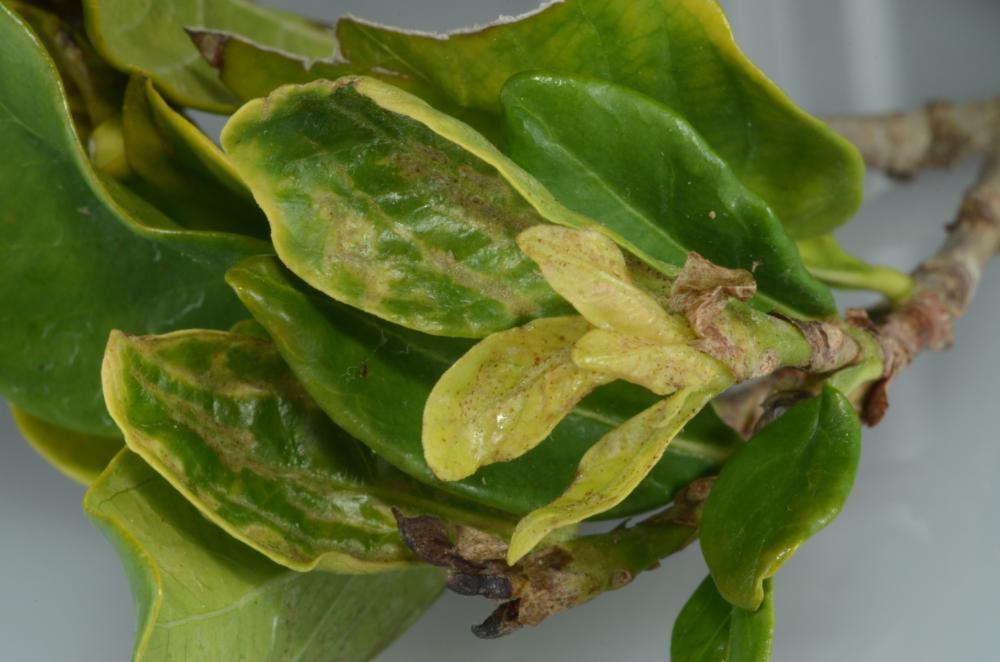 Gardenia terminal damaged by T. parvispinus | University of Florida, Lyle Buss
Thrips parvispinus, also known as pepper thrips or black thrips, is an invasive pest in the order Thysanoptera native to subtropical and tropical areas of southeast Asia. T. parvispinus feeds on a wide variety of vegetable, fruit, and ornamental plants, including economically important crops like potatoes. First found in the United States in Florida in 2020, the pepper thrips has since caused significant damage to gardenia (genus Gardenia) and rock trumpet (genus Mandevilla) plants in that state. T. parvispinus uses its asymmetric mouthparts to rasp plant leaf and flower surfaces as they feed on sap, often damaging buds, restricting plant growth, and reducing crop yields. While DATCP inspectors always check perennials for thrips damage during nursery inspections, we rarely collect samples to identify these pests to species, unless we come across a particularly severe or damaging infestation. However, in spring 2023, USDA-APHIS partners asked Wisconsin and other states to look specifically for this invasive pest to inform potential future regulatory decisions. DATCP nursery inspectors detected T. parvispinus on symptomatic rock trumpet and hibiscus plants verified from six of 11 thrips samples collected during routine annual inspections of licensed nurseries in Dane, Milwaukee, Racine, and Washington counties in May 2023. Although these detections represent new state records for T. parvispinus in Wisconsin, the ease at which this pest was detected once we started collecting samples and identifying this pest to species suggests that T. parvispinus is likely more widespread in commerce in Wisconsin, and across the nation.
Since detected T. parvispinus infestations were present in low levels, and because rock trumpet and hibiscus do not overwinter in Wisconsin, impacts from this pest are not expected to be severe outside of year-round greenhouses. Plants infested with T. parvispinus came from a nursery in Homestead, Florida, so it is clear that this tropical pest is coming in from out-of-state. Inspectors also collected five other samples that came up negative for T. parvispinus but were positive for western flower thrips, eastern flower thrips, and/or banded greenhouse thrips.
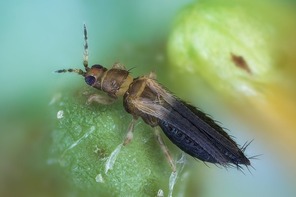
When Wisconsin State Plant Regulatory Official Brian Kuhn attended the National Plant Board meeting in early August, he learned that T. parvispinus is now being found in flowers and peppers in greenhouses in several states. DATCP plans to conduct outreach on this pest, including pest identification information and management recommendations, to licensed nurseries and to the Commercial Growers of Wisconsin, which includes members of the floriculture and greenhouse industry. We will also await guidance from our federal partners at USDA- APHIS on the level of regulatory response warranted by this pest, given the numerous detections of this pest across the nation in 2023. (image above left from thrips-id.com)
For more information about chemical and mechanical controls for T. parvispinus, IPM, and avoiding pesticide resistance, check out this floriculture blog: https://onfloriculture.com/2023/06/19/pesticides-for-parvispinus-results-of-an-on-farm-trial/
|
_____________________________________
|
|
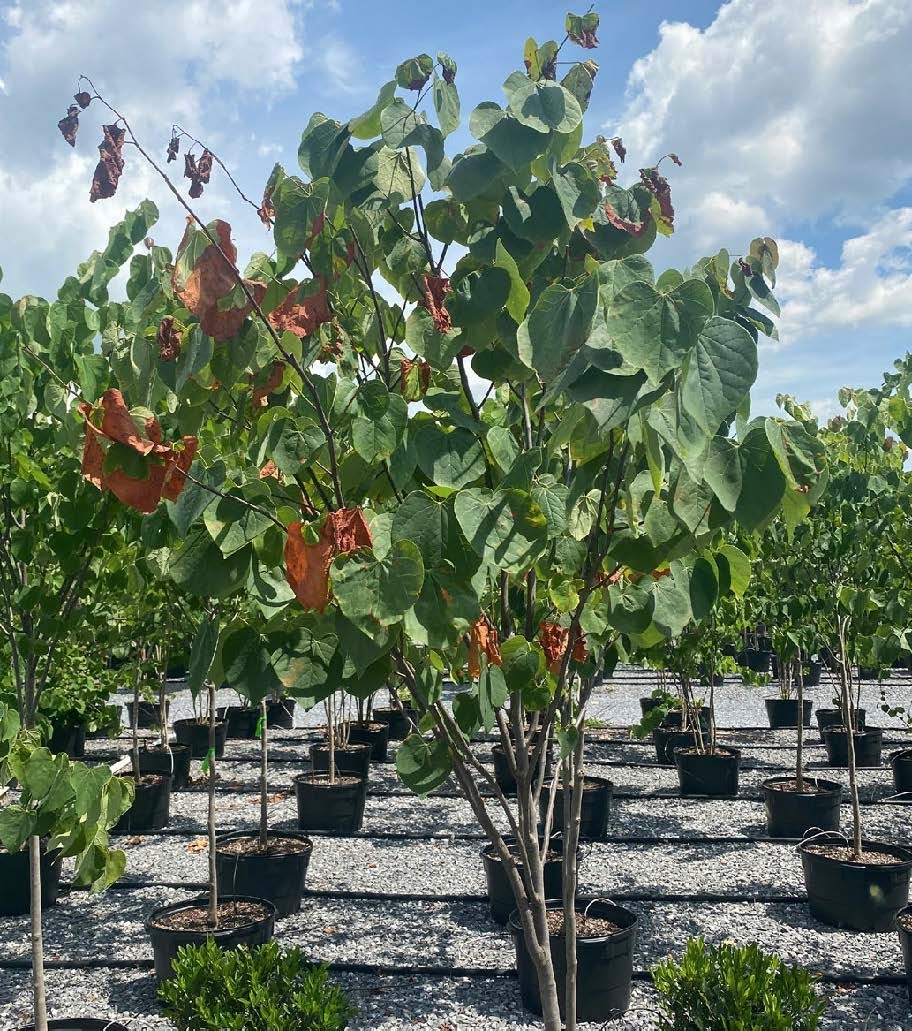 Redbud with leaf scorch, wilting and dieback | Virginia Department of Agriculture and Consumer Services, Devin Bily
Vascular Streak Dieback (VSD) is a newly-discovered plant disease affecting a wide variety of woody ornamentals and trees. VSD is so newly-discovered that the causal organism, or pathogen, for the disease has not yet been confirmed. It is suspected that Ceratobasidium theobromae is the cause of this disease, a fungus best known for causing vascular streak dieback of cacao. This fungus has been consistently isolated from plants exhibiting VSD symptoms where no verticillium wilt, bacterial leaf scorch, or laurel wilt (common diseases of many of the hosts) were isolated. Researchers are still working to confirm the connection between VSD and C. theobromae using Koch’s Postulates.
VSD causes chlorosis, stunting, and dieback of infected plants. Dieback describes the gradual decline of plants through progressively more severe symptoms. Dieback generally starts with blighted or discolored leaves. The infected branches will flag, wilt, and die as the disease progresses. Plant death may occur once the infection reaches the main stem of the plant. Infected plants show streaking and speckling of the plant vascular tissue.
Researchers are working to understand the extent of suspectable hosts to this disease. So far, the most common hosts for this disease are Eastern redbud, flowering dogwood, and red maple. Additional North American hosts include black gum, fragrant sumac, Freeman’s maple, green hawthorn, Northern catalpa, Southern catalpa, serviceberry, spicebush, sweet shrub, tulip poplar, umbrella magnolia, wax myrtle, witch alder, and witch-hazel. Other non-North American native hosts include giant tree lilac, Kousa dogwood, and Paperbark maple.
Vascular Streak Dieback has not been found in Wisconsin. Since this disease is new, we encourage growers to be on the lookout for this disease. If you suspect you may have plants infected with VSD and are a licensed nursery grower, please contact DATCP’s nursery program at (608) 224-4572 or DATCPnursery@wisconsin.gov. If you are a home gardener or horticulture professional and suspect you may have plants infected with VSD, you should contact the University of Wisconsin-Madison Plant Disease Diagnostic Clinic at (608) 262-2863 or bdh@plantpath.wisc.edu.
_____________________________________
|
|
 Drought caused severe losses for growers who couldn't get water to transplants | DATCP K. Jerabek
As drought conditions continue to have an effect across the state, nurseries and Christmas tree growers are likely being affected. The Tree Assistance Program (TAP), operated by USDA’s Farm Service Agency (FSA), may be able to assist qualifying growers with drought losses. TAP provides financial assistance to qualifying orchardists and nursery tree growers to replant or rehabilitate eligible trees, bushes, and vines damaged by natural disasters. According to the U.S. Drought Monitor website, at the close of August, 82% of Wisconsin was in moderate to exceptional (D1-D4) drought. This summer’s (D1-D4) drought peaked in July at 93% coverage, which is the most extensive coverage since July 2005.
- TAP is a cost-share program in which a portion of the cost of replanting or rehabilitation is reimbursed after the work is completed.
- If the producer has not already done so, they will need to file an acreage report with their local FSA office.
- TAP applications must be submitted within 90 days of either the disaster event or the date when the loss became apparent to the producer.
- An environmental assessment and loss verification must take place before the application can be approved. It is important to note, that interested growers must not start any rehabilitation work until AFTER the environmental evaluation has been completed and the TAP application is approved. Starting work beforehand, risks the approval of the application and payment.
_____________________________________
|
|
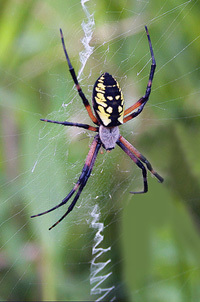
This is the first in a series of articles that focus on the natural predators of many common pest species found in a nursery setting.
One of the most overlooked and often scorned natural predators is the spider. Their large number of legs (and eyes), tendency to build webs in inconvenient places, and venomous bites certainly set them up for distaste. Yet they are important partners in our quest to control pests! Wisconsin is home to many spider species, and they can commonly be found in areas of human activity. (image right: Argiope, commonly called a garden spider, on its web, image credit: UW Horticulture Extension)
There are two main types of spiders you will encounter in the field: active hunters and web builders. Active hunters forgo the typical silk home to actively prowl for their prey. They tend to have good eyesight and can move quickly around to catch prey. They will feed on a variety of insect species, but their diet can include common pests like caterpillars, mites, flies, and grasshoppers. This category includes many groups of spiders such as wolf spiders, jumping spiders, and sac spiders.
Web building spiders use silk glands called spinnerets to create webs capable of catching prey. These webs vary in shape and size but serve similar functions. Some resemble intricate nets strung between plants while others are messy cobwebs tucked into corners. These spiders tend to find single locations to construct their web and wait for prey to become ensnared to feed. They mostly feed on flying insects, like adult moths, flies, and beetles. This category includes the orb weavers, funnel weavers, and cellar spiders.
To best partner with the spiders on your property, you should:
- avoid overapplication of broad-spectrum insecticides, especially those containing pyrethrum. These chemicals will also affect spiders diminishing their ability to provide future pest control.
- provide a cover crop or other planted space for spiders to place their egg sacs.
- avoid clearing webs and other spider habitat, if possible. Spiders spend valuable energy producing silk, which is wasted when webs are destroyed.
|
_____________________________________
|
|
|
This summer, DATCP plant pathologists conducted a survey of 10 Dane County community gardens for Tomato Brown Rugose Fruit Virus (ToBRFV). This virus is a serious pathogen of commercial tomato and pepper production. It was first discovered in 2014 in Israel and has since been detected in Canada, China, Egypt, France, Greece, Italy, Jordan, Mexico, the Netherlands, Palestine, Spain, Turkey, the United Kingdom, and the United States.
ToBRFV is a member of the Tobamovirus group, which includes tobacco mosaic virus, tomato mosaic virus, and pepper mild mottle virus. Tobamoviruses are known for their easy transmissibility and environmental persistence. Like other Tobamoviruses, ToBRFV can easily be transmitted through plant sap, contaminated tools, clothing, seeds, and soil. Its transmissibility and stable nature make this a virus of serious concern to commercial tomato and pepper growers. Symptoms of this virus on tomato and pepper include leaf mottling, mosaic, and chlorosis, as well as fruit discoloration, deformation, necrosis, rugosity, and grooving.
There were no detections of ToBRFV at any of the community gardens surveyed, but gardeners and growers should remain alert for symptoms of this virus. If you suspect your tomato or pepper plants may be infected contact the University of Wisconsin–Madison Plant Disease Diagnostic Clinic at https://pddc.wisc.edu.
|
|
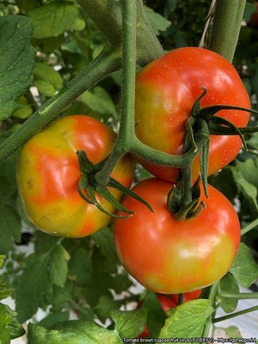 Tomato fruits showing discoloration of fruits. Photo credit: Professor Salvatore Davino, EPPO
|
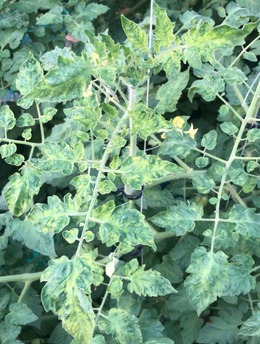 Typical symptoms of ToBRFV. Severe mosaic and deformations. Photo credit: Professor Salvatore Davino, EPPO
|
|
_____________________________________ |
|
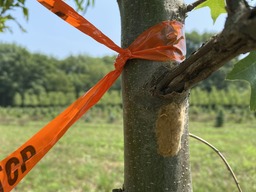 Freshly laid spongy moth (formerly gypsy moth) egg mass found on nursery stock in Jefferson and Kenosha counties | DATCP L. Meils
|
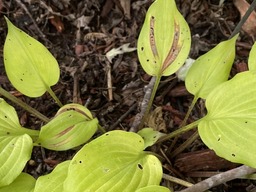 'Tickle me Pink' hosta infected with foliar nematodes in Juneau County | DATCP L. Meils
|
|
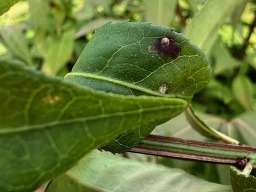 Euonymous infested with Putnam scale in Rock County | DATCP L. Meils
|
 Viburnum Leaf Beetle adults on viburnum in Kenosha County | DATCP M. Wensing
|
|
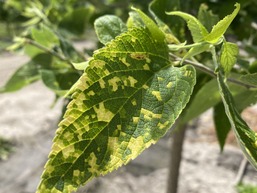 Island chlorosis virus on hackberry found in light amounts across the state | DATCP image
|
 Powdery mildew on assorted stock across the state (shown here on black cherry) | DATCP K. Jerabek
|
|
|
_____________________________________
|
|
|
|
|